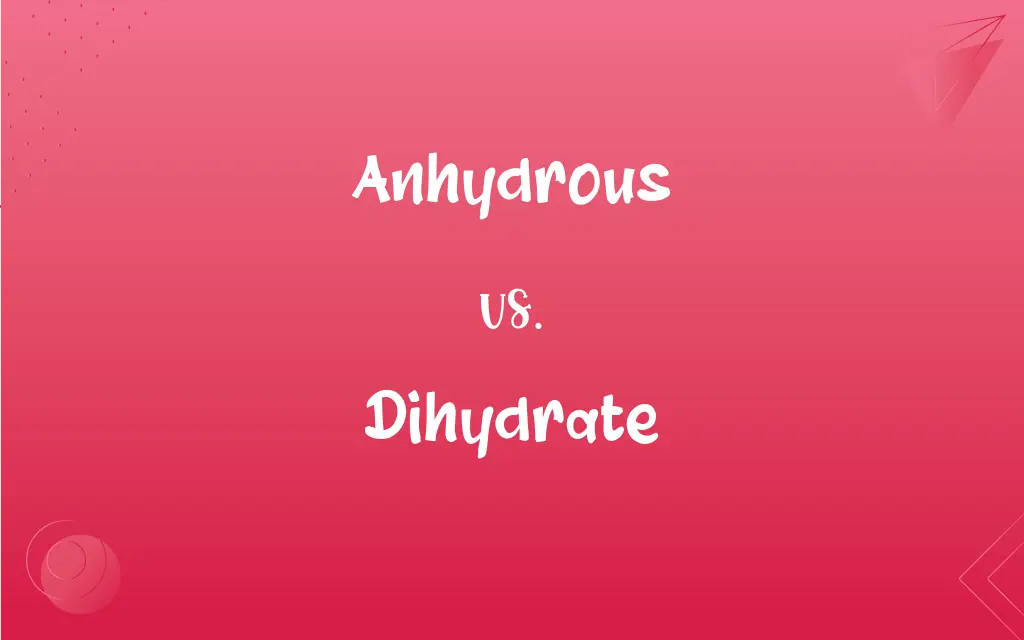Anhydrous vs. Dihydrate: What's the Difference?
Edited by Aimie Carlson || By Janet White || Published on December 25, 2023
Anhydrous substances contain no water, while dihydrates have two water molecules bound in their structure.

Key Differences
Anhydrous compounds are devoid of water molecules, presenting in a completely dry form. Dihydrate compounds, in contrast, integrate two water molecules into their crystalline structure, creating a distinct chemical composition.
In terms of chemical reactions, anhydrous substances can act as powerful drying agents due to their affinity for water. Dihydrates, however, already contain water and are thus less reactive in moisture absorption.
Anhydrous materials are often used in situations requiring absolute dryness, such as in certain laboratory settings or manufacturing processes. Dihydrates, on the other hand, find use in applications where controlled amounts of water are beneficial, such as in hydrating salts.
Stability can differ between anhydrous and dihydrate forms of the same compound. Anhydrous substances might be more volatile or reactive, while dihydrates often exhibit greater stability due to the presence of water molecules.
In pharmaceuticals, anhydrous forms of a drug might differ in potency or absorption rate compared to their dihydrate counterparts, affecting their therapeutic efficacy and shelf life.
ADVERTISEMENT
Comparison Chart
Water Content
Contains no water molecules
Contains two water molecules
Reactivity
Often more reactive, especially to moisture
Less reactive due to inherent water molecules
Uses
Preferred in dry conditions
Used where controlled water is needed
Chemical Stability
Can be less stable
Typically more stable
Pharmaceutical Impact
Differences in potency and absorption
May alter drug release and stability
ADVERTISEMENT
Anhydrous and Dihydrate Definitions
Anhydrous
Not containing any water.
Anhydrous substances are essential in moisture-sensitive reactions.
Dihydrate
Containing two molecules of water.
Copper sulfate dihydrate is blue in color.
Anhydrous
Lacking water.
Anhydrous ammonia is used as a fertilizer.
Dihydrate
Having two waters of crystallization.
Gypsum is calcium sulfate dihydrate.
Anhydrous
Chemically without water.
Anhydrous copper sulfate turns white when it loses water.
Dihydrate
A hydrate with two water molecules per formula unit.
Magnesium sulfate dihydrate is a common Epsom salt.
Anhydrous
In a dry form.
Anhydrous ethanol is used in laboratories.
Dihydrate
A compound with two water molecules.
Sodium sulfate dihydrate is used in detergents.
Anhydrous
Devoid of water molecules.
Anhydrous silica gel is used as a desiccant.
Dihydrate
Two molecules of water in the crystal lattice.
Ferrous sulfate dihydrate is used in iron supplements.
Anhydrous
Without water, especially water of crystallization.
Dihydrate
(chemistry) A hydrate whose solid contains two molecules of water of crystallization per molecule, or per unit cell
Anhydrous
Having little or no water.
Anhydrous
(chemistry) Having no water of crystallization.
Anhydrous
Destitute of water; as, anhydrous salts or acids.
Anhydrous
Without water; especially without water of crystallization
FAQs
What is an example of an anhydrous substance?
Anhydrous calcium chloride, often used as a drying agent.
What does anhydrous mean?
Anhydrous refers to a substance that contains no water molecules.
Can anhydrous substances absorb water?
Yes, many anhydrous substances can absorb water, acting as desiccants.
Are dihydrates less reactive than anhydrous compounds?
Generally, dihydrates are less reactive due to their bound water molecules.
Can a dihydrate be converted to an anhydrous form?
Yes, by heating and removing the water molecules.
Why are anhydrous compounds important in chemistry?
They are crucial in reactions where water presence is detrimental.
What role do dihydrates play in industry?
Dihydrates are used in various applications, like in hydrating salts and detergents.
Are anhydrous substances used in food?
Yes, in forms like anhydrous milk fat.
What is a dihydrate?
A dihydrate is a compound that includes two water molecules in its structure.
Is anhydrous ethanol completely water-free?
Yes, it is ethanol with all water removed.
Is anhydrous sulfuric acid more concentrated than its hydrated form?
Yes, it is more concentrated and reactive.
How does the stability of dihydrates compare to anhydrous forms?
Dihydrates are often more stable due to their inherent water content.
How are dihydrates identified in a lab?
By their water content and crystalline structure.
Do dihydrates release water upon heating?
Yes, they release water when heated, often transitioning to an anhydrous state.
How are anhydrous and dihydrate forms of a drug different?
They may differ in absorption, potency, and stability.
Are anhydrous compounds more expensive than hydrated ones?
It depends on the compound and its production method.
What is a common use of dihydrates in everyday products?
As additives in soaps and detergents.
Can dihydrates act as moisture sources in reactions?
Yes, they can provide controlled moisture in certain chemical reactions.
Can anhydrous compounds be hazardous?
Some, like anhydrous ammonia, can be hazardous due to high reactivity.
What happens to dihydrates in a desiccator?
They may lose water and convert to an anhydrous form.
About Author
Written by
Janet WhiteJanet White has been an esteemed writer and blogger for Difference Wiki. Holding a Master's degree in Science and Medical Journalism from the prestigious Boston University, she has consistently demonstrated her expertise and passion for her field. When she's not immersed in her work, Janet relishes her time exercising, delving into a good book, and cherishing moments with friends and family.
Edited by
Aimie CarlsonAimie Carlson, holding a master's degree in English literature, is a fervent English language enthusiast. She lends her writing talents to Difference Wiki, a prominent website that specializes in comparisons, offering readers insightful analyses that both captivate and inform.






































































